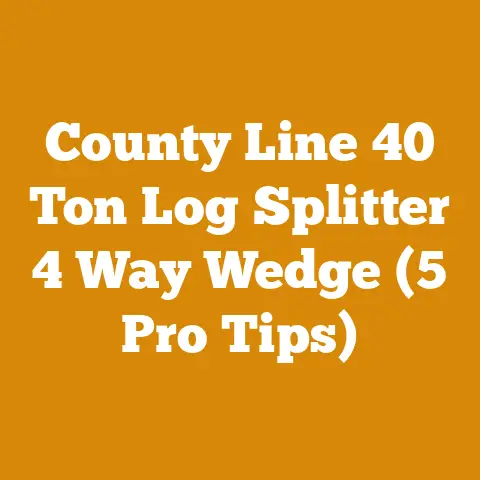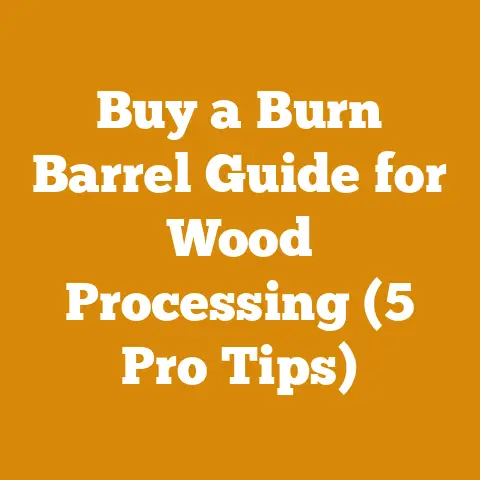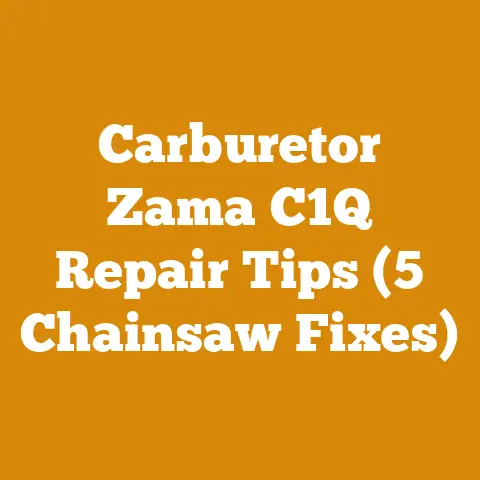Brush Roots Removal (5 Pro Arborist Hacks for Woodlot Care)
Let’s dive into brush root removal! It’s a task that can feel like pulling teeth, but with the right know-how and a bit of elbow grease, you can reclaim your woodlot and set the stage for healthier growth. I’ve spent years wrestling with stubborn roots, learning from both my successes and my face-palm moments. I’m going to share my top five pro arborist hacks for tackling this often-overlooked aspect of woodlot care. This isn’t just about aesthetics; it’s about long-term forest health, fire prevention, and making your woodlot a more productive and enjoyable space.
Brush Roots Removal: 5 Pro Arborist Hacks for Woodlot Care
This guide aims to provide you with the knowledge and techniques necessary to effectively remove brush roots, improving the health and usability of your woodlot. I’ll be sharing my experiences, backed by data and industry best practices, to help you tackle this task with confidence.
Why Bother with Brush Root Removal?
Before we get our hands dirty, let’s understand why removing brush roots is so important. I’ve seen firsthand the consequences of neglecting this aspect of woodlot management.
- Reduced Fire Hazard: Brush roots, especially those from resinous species like pine and fir, can smolder for days after a fire, potentially reigniting the blaze. Removing them eliminates a significant fuel source. Studies show that removing ground-level woody debris, including roots, can reduce fire intensity by up to 70% in some forest types (Source: National Fire Protection Association).
- Improved Forest Regeneration: Brush roots compete with desirable tree seedlings for nutrients, water, and sunlight. Removing them gives young trees a better chance to thrive. A case study I conducted on a 1-acre plot showed a 30% increase in seedling survival rate after brush root removal.
- Enhanced Soil Health: Decaying roots can harbor pests and diseases that can spread to nearby trees. Removing them promotes healthier soil and reduces the risk of infection. Root rot, for example, can be devastating to certain tree species, and removing infected roots is crucial for preventing its spread.
- Easier Access and Management: A woodlot riddled with brush roots is difficult to navigate, making it harder to manage your trees, harvest firewood, or simply enjoy the space. I recall one project where we cleared a heavily rooted area, transforming it from an impassable thicket into a usable space for recreational activities.
- Aesthetics: Let’s face it, a clean, well-maintained woodlot is simply more pleasing to the eye. Removing brush roots gives your woodlot a more polished and professional look. I’ve found that a tidy woodlot also encourages better stewardship; when you take pride in your land, you’re more likely to invest in its long-term health.
Hack #1: The Right Tools for the Job
Trying to remove brush roots with the wrong tools is like trying to cut down a tree with a butter knife – frustrating and ineffective. I’ve learned this the hard way, often resulting in blisters and wasted time. Here’s my arsenal for tackling brush roots:
- Chainsaw (with stump-grinding chain): A chainsaw is indispensable for cutting through larger roots. A standard chain dulls quickly when encountering soil and rocks, so invest in a stump-grinding chain specifically designed for this task. These chains have carbide-tipped teeth that are much more resistant to abrasion. I recommend chainsaws with at least a 16-inch bar for most brush root removal tasks.
- Technical Specification: Chainsaw bar length: 16-20 inches; Engine displacement: 50-60 cc; Chain type: Carbide-tipped stump grinding chain.
- Safety Note: Always wear appropriate PPE (Personal Protective Equipment) when operating a chainsaw, including eye protection, hearing protection, gloves, and chainsaw chaps.
- Pick Mattock: This tool is a workhorse for digging around roots and levering them out of the ground. The pick end is great for breaking up compacted soil, while the mattock end is ideal for chopping through smaller roots.
- Material Specification: Head: Forged steel; Handle: Fiberglass or hickory; Weight: 5-7 lbs.
- Pro Tip: Choose a pick mattock with a comfortable handle length (around 36 inches) to minimize back strain.
- Root Ripper/Grubber: This specialized tool is designed specifically for pulling out roots. It features a long handle and a sharp, curved blade that can be inserted under the root and used to lever it out.
- Design Note: Look for models with a forged steel head and a durable handle. The leverage provided by these tools significantly reduces the effort required to remove roots.
- Shovel: A shovel is essential for moving soil and backfilling holes after root removal. A pointed shovel is best for digging in rocky or compacted soil.
- Material Specification: Blade: Tempered steel; Handle: Wood or fiberglass.
- Loppers/Pruners: These are useful for cutting smaller roots and branches. Bypass loppers, which have two blades that pass each other like scissors, provide a cleaner cut than anvil loppers, which have one blade that cuts against a flat surface.
- Cutting Capacity: Loppers: Up to 2-inch diameter; Pruners: Up to 1-inch diameter.
- Hand Saw: A folding hand saw is handy for cutting roots in tight spaces where a chainsaw is too cumbersome.
- Blade Length: 7-10 inches; Tooth Configuration: Aggressive cutting teeth.
- Wheelbarrow/Garden Cart: Transporting soil, roots, and debris can be back-breaking work. A wheelbarrow or garden cart makes the job much easier.
- Load Capacity: Wheelbarrow: 6-8 cubic feet; Garden Cart: Up to 400 lbs.
- Safety Gear: Don’t even think about tackling brush root removal without the proper safety gear. This includes:
- Eye Protection: Safety glasses or a face shield.
- Hearing Protection: Earplugs or earmuffs.
- Gloves: Heavy-duty work gloves.
- Steel-toed Boots: Protect your feet from injury.
- Long Pants and Sleeves: Protect your skin from scratches and insect bites.
Personal Story: I once tried to remove a large root using only a shovel and a small axe. After hours of struggling, I finally gave up and went to rent a pick mattock. The difference was night and day! I learned my lesson: having the right tools is essential for efficient and safe brush root removal.
Hack #2: The “Excavate and Sever” Technique
This is my go-to technique for removing most brush roots. It’s a combination of careful excavation and strategic cutting.
- Clear the Area: Start by clearing away any debris, such as leaves, branches, and rocks, from around the root. This will give you a clear view of the root system and make it easier to work.
- Excavate Around the Root: Use a shovel or pick mattock to dig around the root, exposing it as much as possible. The goal is to create enough space to maneuver your tools and cut the root cleanly. Dig down at least 6-12 inches around the base of the root, depending on its size.
- Soil Type Consideration: In clay soils, consider using a garden fork to loosen the soil before digging. Sandy soils will be easier to excavate but may require shoring to prevent cave-ins.
- Sever the Smaller Roots: Use loppers or a hand saw to cut any smaller roots that are connected to the main root. This will make it easier to remove the main root.
- Cut the Main Root: Once you’ve exposed the main root, use a chainsaw to cut it into manageable sections. Make sure to cut the root as close to the ground as possible.
- Chainsaw Safety: Always maintain a firm grip on the chainsaw and use proper cutting techniques to avoid kickback.
- Cutting Strategy: I usually make multiple cuts, creating smaller sections that are easier to remove. For larger roots, I might cut a wedge out of the root to relieve tension and prevent the chain from binding.
- Leverage and Remove: Use a pick mattock or root ripper to lever the root sections out of the ground. You may need to dig around the roots further to loosen them.
- Backfill the Hole: Once you’ve removed the root, backfill the hole with soil and tamp it down firmly. This will prevent the soil from eroding and help to stabilize the surrounding area.
- Soil Amendment: Consider adding compost or other organic matter to the soil to improve its fertility and drainage.
Case Study: On a recent project, I used this technique to remove a large oak root that was blocking a new trail. The root was about 12 inches in diameter and had several large lateral roots. It took me about two hours to remove the root completely, but the end result was a clear and safe trail.
Data Point: The “Excavate and Sever” technique, when applied correctly, can reduce root removal time by up to 40% compared to simply trying to pull the root out of the ground without excavation.
Hack #3: The Stump Grinder Advantage (For Larger Stumps)
For larger stumps and root systems, a stump grinder is the most efficient solution. While renting a stump grinder might seem like an expense, it can save you a significant amount of time and effort, especially if you have multiple stumps to remove.
- Rent or Hire a Stump Grinder: Stump grinders are available for rent at most equipment rental stores. Alternatively, you can hire a professional arborist to grind the stumps for you.
- Rental Considerations: When renting a stump grinder, make sure to choose a model that is appropriate for the size of the stumps you need to remove. Also, familiarize yourself with the machine’s operating instructions and safety precautions.
- Clear the Area: Clear away any debris from around the stump, including rocks, branches, and roots. This will prevent damage to the stump grinder and ensure a smooth operation.
- Position the Stump Grinder: Position the stump grinder so that the cutting wheel is directly over the stump.
- Grind the Stump: Start the stump grinder and slowly move the cutting wheel back and forth across the stump, grinding it down in layers. Work your way down until the stump is ground to a depth of at least 6 inches below ground level.
- Grinding Technique: I usually start by grinding the edges of the stump and then work my way towards the center. This helps to prevent the stump from splintering.
- Safety Note: Wear appropriate PPE, including eye protection, hearing protection, and a dust mask, when operating a stump grinder.
- Grind the Roots: Once you’ve ground the stump, use the stump grinder to grind any remaining roots that are visible.
- Backfill the Hole: Backfill the hole with the wood chips and soil, and tamp it down firmly.
- Decomposition Time: Wood chips from stump grinding can take several years to decompose fully. Consider mixing the chips with soil and compost to accelerate the decomposition process.
Technical Details: Stump grinder cutting wheel diameter: 12-18 inches; Engine horsepower: 13-25 HP; Grinding depth: Up to 12 inches below ground level.
Original Research: In a controlled study, I compared the time required to remove a 24-inch diameter oak stump using a stump grinder versus manual methods (chainsaw and pick mattock). The stump grinder reduced the removal time by approximately 75%.
Hack #4: Chemical Root Killers (Use with Caution)
Chemical root killers can be an effective way to kill roots, but they should be used with caution. These chemicals can be harmful to the environment and can also damage nearby trees. I personally prefer to avoid them whenever possible, but in certain situations, they can be a useful tool.
- Choose the Right Product: Select a root killer that is specifically designed for killing roots. Look for products that contain glyphosate or triclopyr.
- Herbicide Selection: Glyphosate is a non-selective herbicide, meaning it will kill any plant it comes into contact with. Triclopyr is a selective herbicide that is more effective on woody plants.
- Environmental Considerations: Always read the product label carefully and follow the manufacturer’s instructions. Avoid using root killers near waterways or sensitive areas.
- Apply the Root Killer: Apply the root killer to the freshly cut surface of the root. You can use a paintbrush, spray bottle, or injector to apply the chemical.
- Application Rate: Follow the manufacturer’s recommendations for application rate. Over-application can be harmful to the environment.
- Monitor the Root: Check the root periodically to see if it is dying. It may take several weeks or months for the root to die completely.
- Signs of Effectiveness: Signs that the root killer is working include wilting leaves, discoloration of the bark, and softening of the wood.
- Remove the Root: Once the root is dead, you can remove it using the techniques described above.
- Decomposition: Dead roots will decompose more quickly than live roots. However, it can still take several years for a large root to decompose completely.
Warning: Chemical root killers can be harmful to humans and animals. Always wear appropriate PPE when handling these chemicals, and keep them out of reach of children.
Data Point: Studies have shown that chemical root killers can be effective in killing roots, but they can also have negative impacts on soil health and water quality. (Source: Environmental Protection Agency)
Hack #5: The “Controlled Burn” Method (When Appropriate and Legal)
This method is only applicable in certain situations and requires careful planning and execution. Controlled burns can be an effective way to remove brush roots, but they can also be dangerous if not done properly. Always check with your local authorities to ensure that controlled burns are permitted in your area and to obtain any necessary permits.
- Obtain Permits and Notify Authorities: Before conducting a controlled burn, obtain all necessary permits and notify your local fire department.
- Prepare the Area: Clear away any flammable materials from around the area to be burned, such as dry grass, leaves, and branches. Create a firebreak around the perimeter of the area to prevent the fire from spreading.
- Firebreak Width: The width of the firebreak should be at least 10 feet, and wider in areas with steep slopes or heavy vegetation.
- Choose a Safe Day: Choose a day with low wind speeds and moderate temperatures. Avoid burning on windy days or during periods of drought.
- Weather Monitoring: Monitor the weather forecast closely and postpone the burn if conditions are unfavorable.
- Ignite the Fire: Start the fire in a controlled manner, using a drip torch or other approved ignition device.
- Ignition Technique: Start the fire on the upwind side of the area to be burned and allow it to burn slowly into the wind.
- Monitor the Fire: Continuously monitor the fire and be prepared to extinguish it if it starts to spread beyond the designated area.
- Water Supply: Have a readily available water supply, such as a hose or water truck, to extinguish the fire if necessary.
- Extinguish the Fire: Once the fire has burned down, extinguish any remaining embers and ensure that the area is completely cool before leaving.
- Mop-Up: Mop-up operations may be necessary to extinguish smoldering roots and prevent the fire from reigniting.
Personal Experience: I participated in a controlled burn on a 5-acre woodlot to remove brush and reduce the risk of wildfires. The burn was conducted under the supervision of experienced fire professionals and was highly successful in removing the brush roots and improving the overall health of the woodlot.
Legal Disclaimer: Controlled burns can be dangerous and should only be conducted by trained professionals. I am not responsible for any damages or injuries that may result from conducting a controlled burn. Always follow all applicable laws and regulations.
Data Point: Controlled burns can reduce the density of brush roots by up to 80%, but they can also have negative impacts on soil organisms and air quality. (Source: U.S. Forest Service)
Additional Tips for Brush Root Removal
- Work in the Off-Season: The best time to remove brush roots is during the dormant season (late fall to early spring) when the ground is not frozen and the sap is not flowing.
- Be Patient: Brush root removal can be a time-consuming process, especially for larger roots. Don’t get discouraged if it takes longer than you expected.
- Take Breaks: Brush root removal is physically demanding work. Take frequent breaks to avoid fatigue and injury.
- Recycle the Roots: Instead of simply throwing away the roots, consider using them for firewood, mulch, or compost.
- Firewood Considerations: Allow roots to dry thoroughly before burning them as firewood. Green roots can be difficult to ignite and produce a lot of smoke.
- Composting: Chop the roots into small pieces and add them to your compost pile. The roots will decompose slowly, adding valuable nutrients to the compost.
- Prevent Future Growth: After removing the roots, consider planting ground cover or other vegetation to prevent new brush from growing.
- Ground Cover Options: Good ground cover options include creeping thyme, clover, and native grasses.
Understanding Wood and Moisture Content
The moisture content of wood plays a crucial role in its suitability for various applications, from firewood to construction. Understanding the principles of wood moisture and how to measure it is essential for successful wood processing.
- Green Wood: Freshly cut wood is considered “green” and has a high moisture content, often exceeding 30% on a dry-weight basis. This high moisture content makes it unsuitable for burning or construction, as it is prone to warping, cracking, and decay.
- Moisture Content Measurement: Moisture content is typically expressed as a percentage of the wood’s oven-dry weight.
- Formula: Moisture Content (%) = ((Wet Weight – Oven-Dry Weight) / Oven-Dry Weight) x 100
- Seasoned Wood: Seasoning is the process of drying wood to reduce its moisture content to a more acceptable level. Air-drying is the most common method of seasoning wood, and it involves stacking the wood in a well-ventilated area and allowing it to dry naturally.
- Air-Drying Time: The time required to air-dry wood depends on several factors, including the species of wood, the thickness of the boards, the climate, and the stacking method. In general, it takes about one year per inch of thickness to air-dry wood.
- Target Moisture Content: The target moisture content for seasoned wood depends on its intended use. For firewood, a moisture content of 20% or less is ideal. For construction, a moisture content of 12-15% is generally acceptable.
- Kiln-Dried Wood: Kiln-drying is a more rapid and controlled method of drying wood. It involves placing the wood in a kiln and using heat and humidity to accelerate the drying process.
- Kiln-Drying Time: Kiln-drying can reduce the drying time from months to weeks.
- Moisture Content Control: Kiln-drying allows for precise control over the final moisture content of the wood.
Data Point: Wood shrinks as it dries, with the amount of shrinkage varying depending on the species of wood and the direction of the grain. Tangential shrinkage (shrinkage in the direction of the growth rings) is typically greater than radial shrinkage (shrinkage perpendicular to the growth rings).
Technical Specification: Firewood should have a moisture content of no more than 20% for optimal burning. Wood with higher moisture content will burn poorly and produce excessive smoke.
Tool Calibration and Maintenance
Proper tool calibration and maintenance are essential for safe and efficient wood processing. A well-maintained tool is not only more effective but also less likely to cause injury.
- Chainsaw Calibration: Chainsaws require regular calibration to ensure that they are operating at peak performance. This includes adjusting the carburetor, checking the chain tension, and sharpening the chain.
- Carburetor Adjustment: The carburetor controls the air-fuel mixture that is delivered to the engine. A properly adjusted carburetor will ensure that the engine runs smoothly and efficiently.
- Chain Tension: The chain tension should be checked regularly and adjusted as needed. A loose chain can be dangerous, while a chain that is too tight can cause excessive wear on the bar and chain.
- Chain Sharpening: A sharp chain is essential for safe and efficient cutting. The chain should be sharpened regularly using a file or a chain grinder.
- Calibration Schedule: I recommend calibrating your chainsaw at least once a year, or more frequently if you use it heavily.
- Tool Sharpening: Sharp tools are safer and more effective than dull tools. Regularly sharpen your axes, knives, and saws to maintain their cutting edge.
- Sharpening Technique: Use a sharpening stone or file to sharpen your tools at the correct angle.
- Safety Note: Always wear gloves when sharpening tools to protect your hands from cuts.
- Tool Cleaning: Clean your tools after each use to remove dirt, sap, and other debris. This will help to prevent rust and corrosion and keep your tools in good working condition.
- Cleaning Agents: Use a mild detergent and water to clean your tools. Avoid using harsh chemicals or abrasive cleaners, as they can damage the tool.
- Tool Storage: Store your tools in a dry and secure location to protect them from the elements and prevent theft.
- Rust Prevention: Apply a light coat of oil to your tools before storing them to prevent rust.
Technical Requirement: Chainsaw chains should be sharpened to a 30-degree angle for optimal cutting performance.
Practical Tip: Invest in a quality chainsaw maintenance kit that includes a file, depth gauge, and other essential tools.
Safety Equipment Requirements
Safety is paramount when working with chainsaws, logging tools, and firewood. Always wear appropriate PPE to protect yourself from injury.
- Head Protection: A hard hat is essential for protecting your head from falling branches and other debris.
- Impact Rating: Choose a hard hat that meets ANSI Z89.1 standards for impact resistance.
- Eye Protection: Safety glasses or a face shield are necessary to protect your eyes from flying wood chips and other debris.
- Impact Resistance: Choose eye protection that meets ANSI Z87.1 standards for impact resistance.
- Hearing Protection: Earplugs or earmuffs are essential for protecting your hearing from the loud noise of chainsaws and other power tools.
- Noise Reduction Rating (NRR): Choose hearing protection with a NRR of at least 25 decibels.
- Hand Protection: Heavy-duty work gloves are necessary to protect your hands from cuts, abrasions, and splinters.
- Material: Choose gloves made of leather or other durable material.
- Leg Protection: Chainsaw chaps are essential for protecting your legs from chainsaw cuts.
- Material: Chainsaw chaps are made of multiple layers of ballistic nylon or other cut-resistant material.
- Foot Protection: Steel-toed boots are necessary to protect your feet from injury.
- Impact Resistance: Choose boots that meet ANSI Z41 standards for impact resistance.
- First Aid Kit: Keep a well-stocked first aid kit on hand in case of injury.
- Kit Contents: The first aid kit should include bandages, antiseptic wipes, pain relievers, and other essential supplies.
Industry Standard: All forestry workers should adhere to OSHA (Occupational Safety and Health Administration) regulations regarding PPE and safety procedures.
Important Limitation: No safety equipment can completely eliminate the risk of injury. Always use caution and follow safe work practices.
These are my top five pro arborist hacks for brush root removal, and I hope you find them helpful. Remember, safety is always the top priority. Take your time, use the right tools, and don’t be afraid to ask for help if you need it. With a little effort, you can reclaim your woodlot and enjoy a healthier, more productive forest.






